MERCEDES-BENZ G-Class 2012 W463 Owner's Manual
Manufacturer: MERCEDES-BENZ, Model Year: 2012, Model line: G-Class, Model: MERCEDES-BENZ G-Class 2012 W463Pages: 284, PDF Size: 9.4 MB
Page 181 of 284
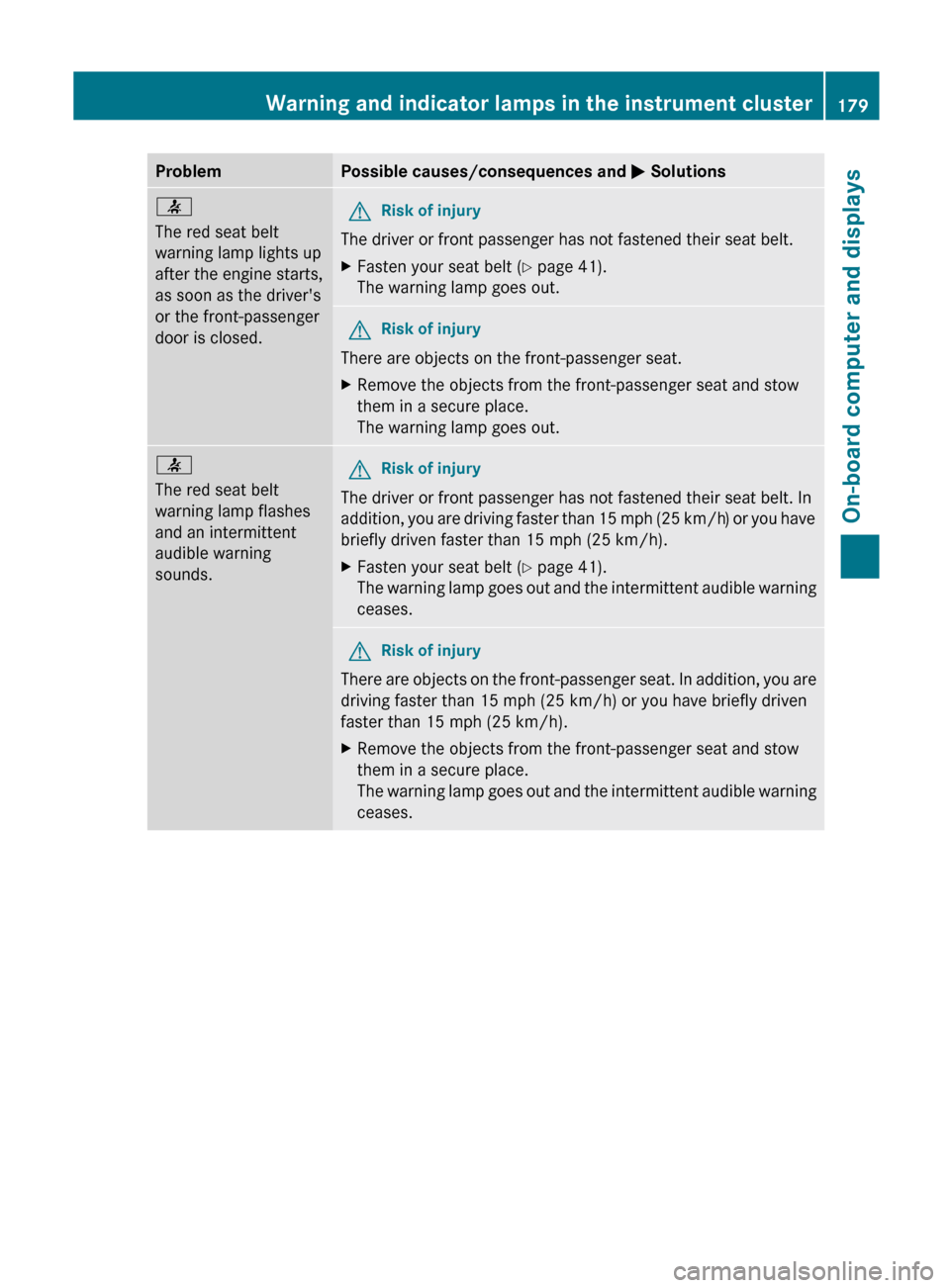
Problem Possible causes/consequences and
M Solutions7
The red seat belt
warning lamp lights up
after the engine starts,
as soon as the driver's
or the front-passenger
door is closed.
G
Risk of injury
The driver or front passenger has not fastened their seat belt.
X Fasten your seat belt ( Y page 41).
The warning lamp goes out. G
Risk of injury
There are objects on the front-passenger seat.
X Remove the objects from the front-passenger seat and stow
them in a secure place.
The warning lamp goes out. 7
The red seat belt
warning lamp flashes
and an intermittent
audible warning
sounds.
G
Risk of injury
The driver or front passenger has not fastened their seat belt. In
addition, you
are driving faster than 15 mph (25 km/h) or you have
briefly driven faster than 15 mph (25 km/h).
X Fasten your seat belt ( Y page 41).
The warning
lamp goes out and the intermittent audible warning
ceases. G
Risk of injury
There are objects on the front-passenger seat. In addition, you are
driving faster than 15 mph (25 km/h ) or you have briefly driven
faster than 15 mph (25 km/h
).
X Remove the objects from the front-passenger seat and stow
them in a secure place.
The warning
lamp goes out and the intermittent audible warning
ceases. Warning and indicator lamps in the instrument cluster
179
On-board computer and displays Z
Page 182 of 284
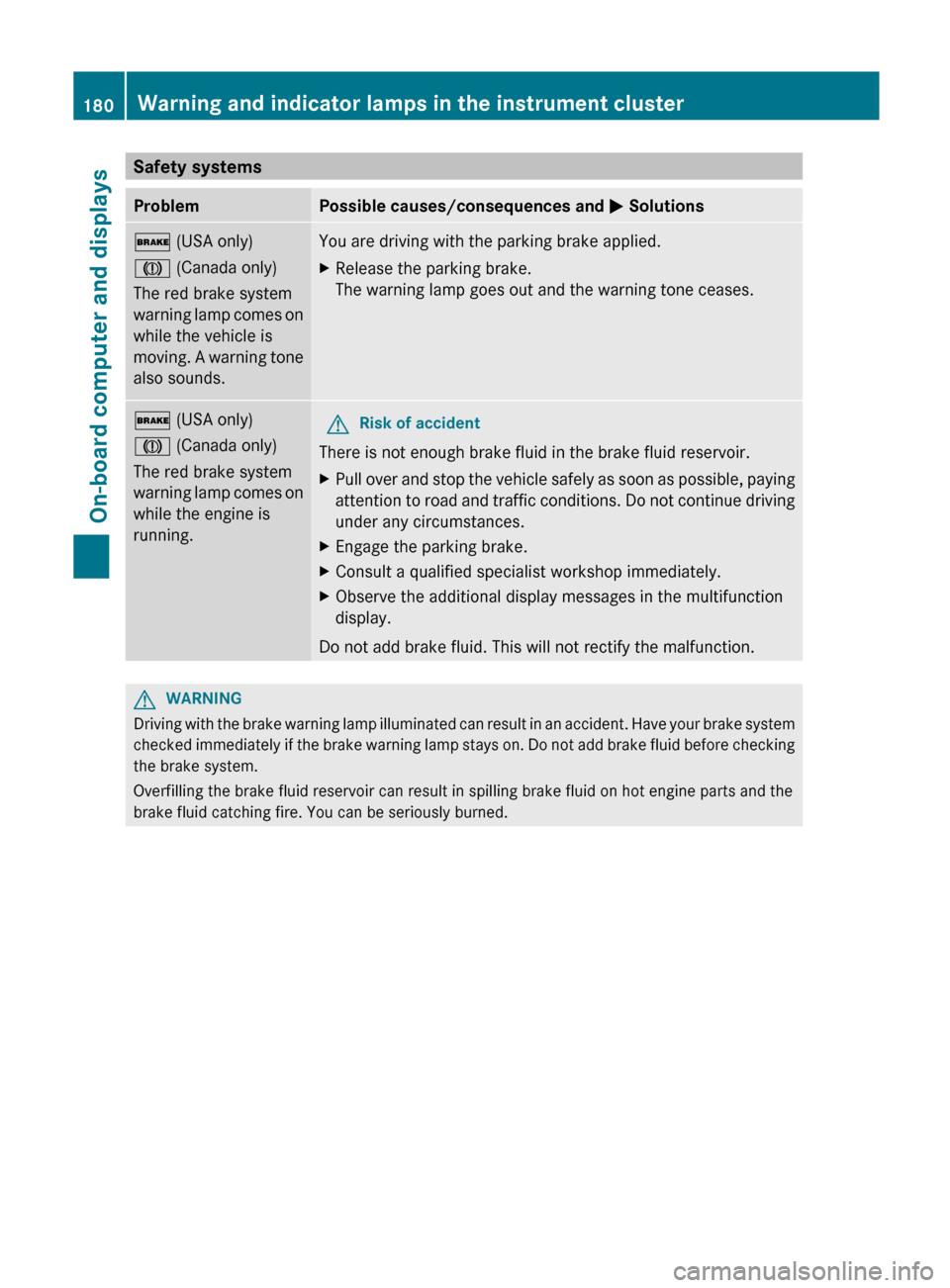
Safety systems
Problem Possible causes/consequences and
M Solutions
$ (USA only)
J (Canada only)
The red brake system
warning lamp
comes on
while the vehicle is
moving. A warning tone
also sounds. You are driving with the parking brake applied.
X
Release the parking brake.
The warning lamp goes out and the warning tone ceases. $
(USA only)
J (Canada only)
The red brake system
warning lamp
comes on
while the engine is
running. G
Risk of accident
There is not enough brake fluid in the brake fluid reservoir.
X Pull
over and stop the vehicle safely as soon as possible, paying
attention to
road and traffic conditions. Do not continue driving
under any circumstances.
X Engage the parking brake.
X Consult a qualified specialist workshop immediately.
X Observe the additional display messages in the multifunction
display.
Do not add brake fluid. This will not rectify the malfunction. G
WARNING
Driving
with the brake warning lamp illuminated can result in an accident. Have your brake system
checked immediately
if the brake warning lamp stays on. Do not add brake fluid before checking
the brake system.
Overfilling the brake fluid reservoir can result in spilling brake fluid on hot engine parts and the
brake fluid catching fire. You can be seriously burned. 180
Warning and indicator lamps in the instrument cluster
On-board computer and displays
Page 183 of 284
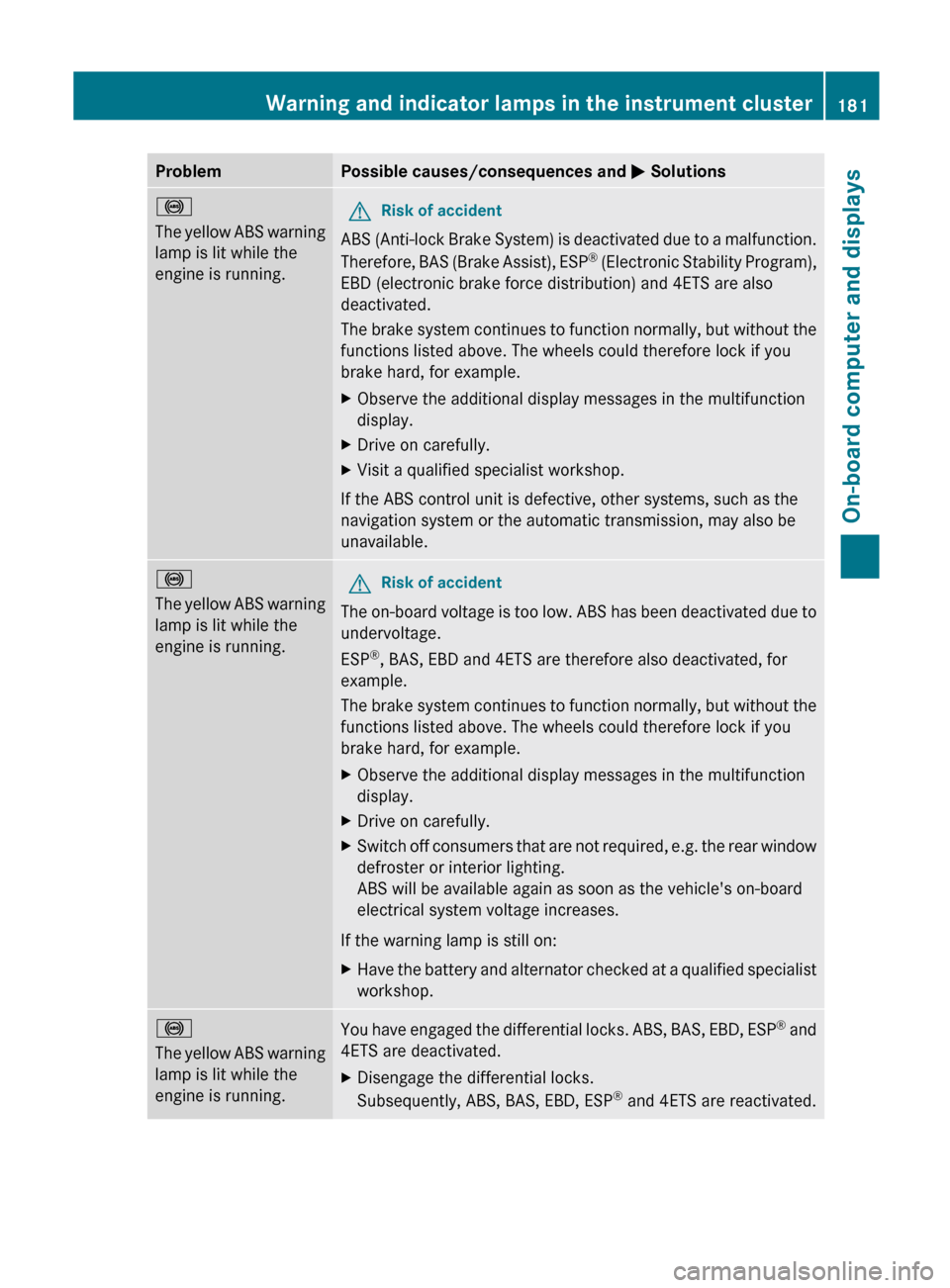
Problem Possible causes/consequences and
M Solutions!
The
yellow
ABS warning
lamp is lit while the
engine is running. G
Risk of accident
ABS (Anti-lock Brake System) is deactivated due to a malfunction.
Therefore, BAS
(Brake Assist), ESP ®
(Electronic Stability Program),
EBD (electronic brake force distribution) and 4ETS are also
deactivated.
The brake system continues to function normally, but without the
functions listed above. The wheels could therefore lock if you
brake hard, for example.
X Observe the additional display messages in the multifunction
display.
X Drive on carefully.
X Visit a qualified specialist workshop.
If the ABS control unit is defective, other systems, such as the
navigation system or the automatic transmission, may also be
unavailable. !
The
yellow
ABS warning
lamp is lit while the
engine is running. G
Risk of accident
The on-board voltage is too low. ABS has been deactivated due to
undervoltage.
ESP ®
, BAS, EBD and 4ETS are therefore also deactivated, for
example.
The brake
system continues to function normally, but without the
functions listed above. The wheels could therefore lock if you
brake hard, for example.
X Observe the additional display messages in the multifunction
display.
X Drive on carefully.
X Switch off consumers that are not required, e.g. the rear window
defroster or interior lighting.
ABS will be available again as soon as the vehicle's on-board
electrical system voltage increases.
If the warning lamp is still on:
X Have the battery and alternator checked at a qualified specialist
workshop. !
The
yellow
ABS warning
lamp is lit while the
engine is running. You have engaged the differential locks. ABS, BAS, EBD, ESP
®
and
4ETS are deactivated.
X Disengage the differential locks.
Subsequently, ABS, BAS, EBD, ESP ®
and 4ETS are reactivated. Warning and indicator lamps in the instrument cluster
181
On-board computer and displays Z
Page 184 of 284
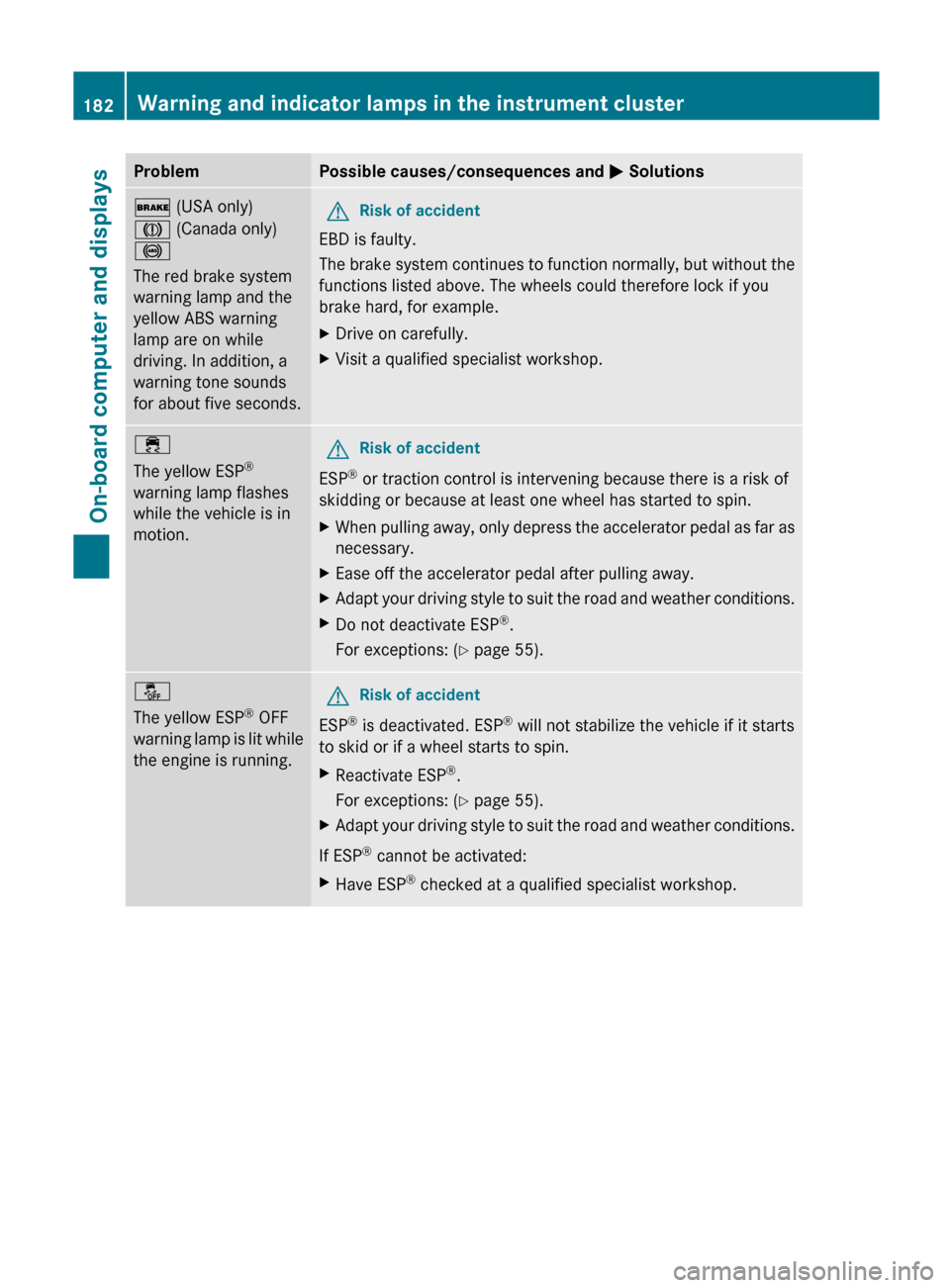
Problem Possible causes/consequences and
M Solutions$ (USA only)
J (Canada only)
!
The red brake system
warning lamp and the
yellow ABS warning
lamp are on while
driving. In addition, a
warning tone sounds
for about five seconds.
G
Risk of accident
EBD is faulty.
The brake
system continues to function normally, but without the
functions listed above. The wheels could therefore lock if you
brake hard, for example.
X Drive on carefully.
X Visit a qualified specialist workshop. ÷
The yellow ESP
®
warning lamp flashes
while the vehicle is in
motion. G
Risk of accident
ESP ®
or traction control is intervening because there is a risk of
skidding or because at least one wheel has started to spin.
X When pulling away, only depress the accelerator pedal as far as
necessary.
X Ease off the accelerator pedal after pulling away.
X Adapt your driving style to suit the road and weather conditions.
X Do not deactivate ESP ®
.
For exceptions: (
Y page 55).å
The yellow ESP
®
OFF
warning lamp
is lit while
the engine is running. G
Risk of accident
ESP ®
is deactivated. ESP ®
will not stabilize the vehicle if it starts
to skid or if a wheel starts to spin.
X Reactivate ESP ®
.
For exceptions: (
Y page 55).
X Adapt your driving style to suit the road and weather conditions.
If ESP ®
cannot be activated:
X Have ESP ®
checked at a qualified specialist workshop. 182
Warning and indicator lamps in the instrument cluster
On-board computer and displays
Page 185 of 284
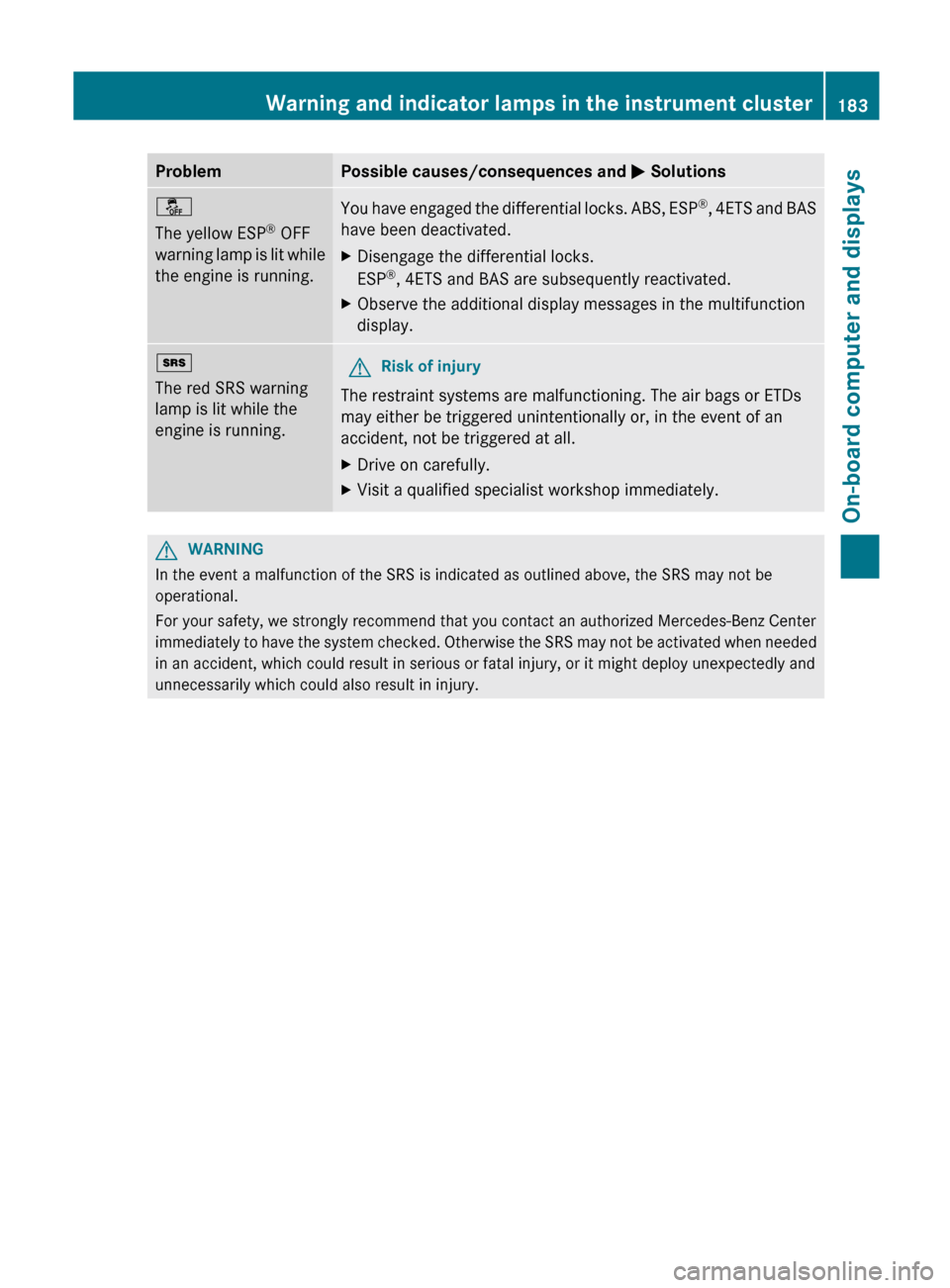
Problem Possible causes/consequences and
M Solutionså
The yellow ESP
®
OFF
warning lamp
is lit while
the engine is running. You have engaged the differential locks. ABS, ESP
®
, 4ETS and BAS
have been deactivated.
X Disengage the differential locks.
ESP ®
, 4ETS and BAS are subsequently reactivated.
X Observe the additional display messages in the multifunction
display. +
The red SRS warning
lamp is lit while the
engine is running.
G
Risk of injury
The restraint systems are malfunctioning. The air bags or ETDs
may either be triggered unintentionally or, in the event of an
accident, not be triggered at all.
X Drive on carefully.
X Visit a qualified specialist workshop immediately. G
WARNING
In the event a malfunction of the SRS is indicated as outlined above, the SRS may not be
operational.
For your safety, we strongly recommend that you contact an authorized Mercedes-Benz Center
immediately to
have the system checked. Otherwise the SRS may not be activated when needed
in an accident, which could result in serious or fatal injury, or it might deploy unexpectedly and
unnecessarily which could also result in injury. Warning and indicator lamps in the instrument cluster
183
On-board computer and displays Z
Page 186 of 284
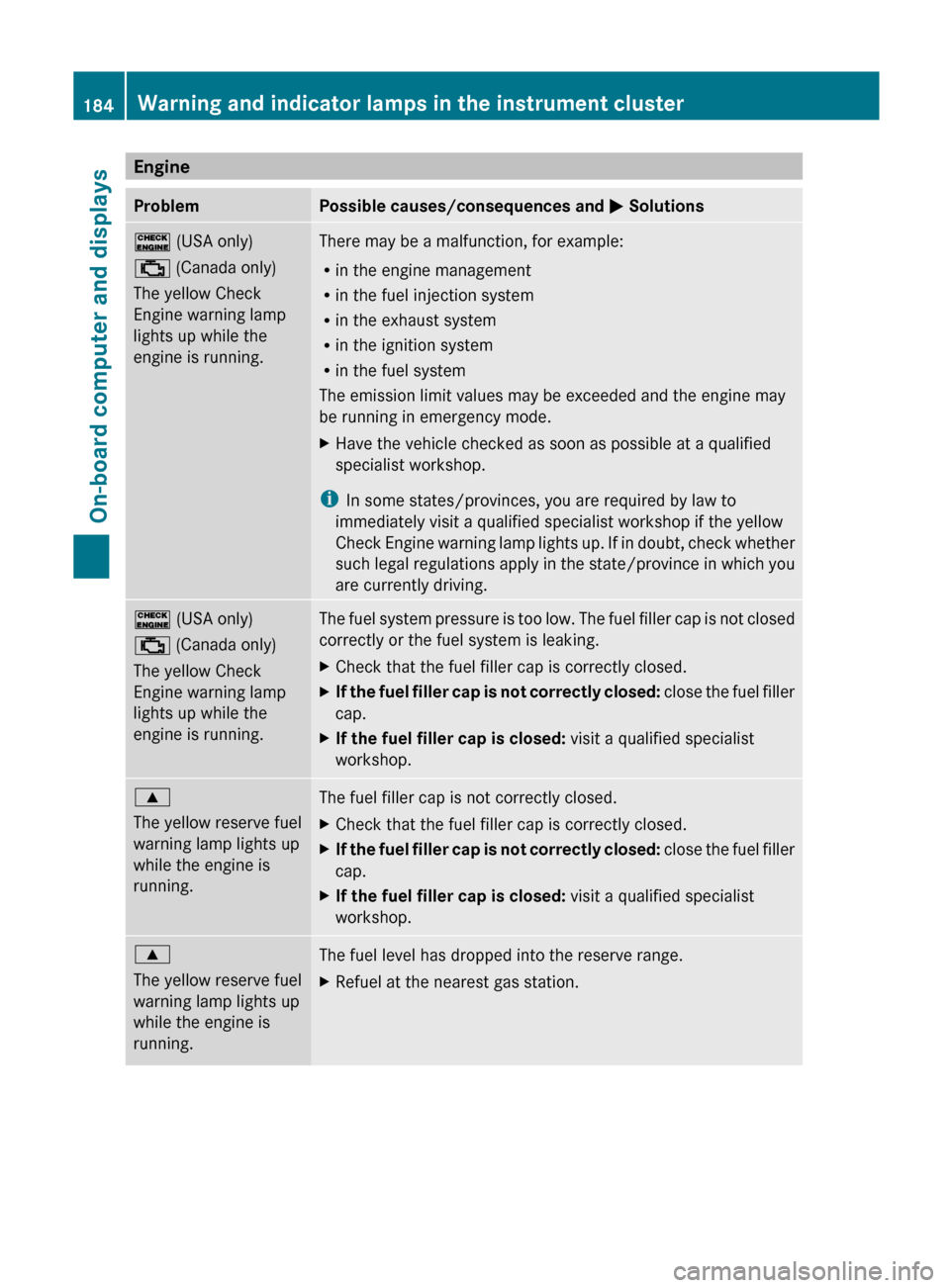
Engine
Problem Possible causes/consequences and
M Solutions
! (USA only)
; (Canada only)
The yellow Check
Engine warning lamp
lights up while the
engine is running. There may be a malfunction, for example:
R
in the engine management
R in the fuel injection system
R in the exhaust system
R in the ignition system
R in the fuel system
The emission limit values may be exceeded and the engine may
be running in emergency mode.
X Have the vehicle checked as soon as possible at a qualified
specialist workshop.
i In some states/provinces, you are required by law to
immediately visit a qualified specialist workshop if the yellow
Check Engine
warning lamp lights up. If in doubt, check whether
such legal regulations apply in the state/province in which you
are currently driving. !
(USA only)
; (Canada only)
The yellow Check
Engine warning lamp
lights up while the
engine is running. The fuel system pressure is too low. The fuel filler cap is not closed
correctly or the fuel system is leaking.
X Check that the fuel filler cap is correctly closed.
X If the fuel filler cap is not correctly closed:
close
the fuel filler
cap.
X If the fuel filler cap is closed: visit a qualified specialist
workshop. 9
The yellow reserve fuel
warning lamp lights up
while the engine is
running.
The fuel filler cap is not correctly closed.
X
Check that the fuel filler cap is correctly closed.
X If
the fuel filler cap is not correctly closed:
close
the fuel filler
cap.
X If the fuel filler cap is closed: visit a qualified specialist
workshop. 9
The yellow reserve fuel
warning lamp lights up
while the engine is
running.
The fuel level has dropped into the reserve range.
X
Refuel at the nearest gas station.184
Warning and indicator lamps in the instrument cluster
On-board computer and displays
Page 187 of 284
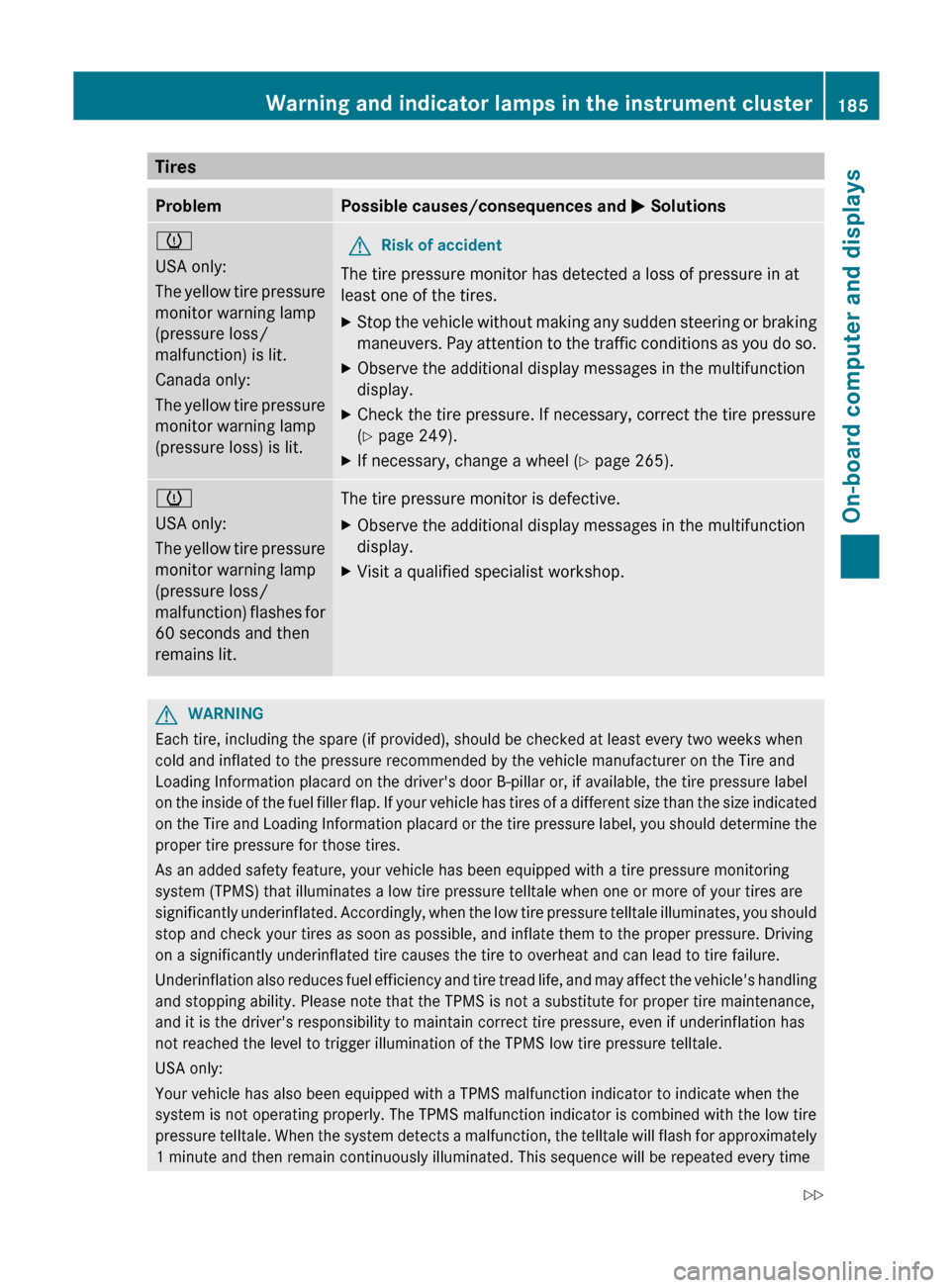
Tires
Problem Possible causes/consequences and
M Solutions
h
USA only:
The
yellow
tire pressure
monitor warning lamp
(pressure loss/
malfunction) is lit.
Canada only:
The yellow tire pressure
monitor warning lamp
(pressure loss) is lit. G
Risk of accident
The tire pressure monitor has detected a loss of pressure in at
least one of the tires.
X Stop
the vehicle without making any sudden steering or braking
maneuvers. Pay
attention to the traffic conditions as you do so.
X Observe the additional display messages in the multifunction
display.
X Check the tire pressure. If necessary, correct the tire pressure
(Y page 249).
X If necessary, change a wheel ( Y page 265).h
USA only:
The
yellow
tire pressure
monitor warning lamp
(pressure loss/
malfunction) flashes for
60 seconds and then
remains lit. The tire pressure monitor is defective.
X
Observe the additional display messages in the multifunction
display.
X Visit a qualified specialist workshop. G
WARNING
Each tire, including the spare (if provided), should be checked at least every two weeks when
cold and inflated to the pressure recommended by the vehicle manufacturer on the Tire and
Loading Information placard on the driver's door B-pillar or, if available, the tire pressure label
on
the inside of the fuel filler flap. If your vehicle has tires of a different size than the size indicated
on the Tire and Loading Information placard or the tire pressure label, you should determine the
proper tire pressure for those tires.
As an added safety feature, your vehicle has been equipped with a tire pressure monitoring
system (TPMS) that illuminates a low tire pressure telltale when one or more of your tires are
significantly underinflated. Accordingly, when the low tire pressure telltale illuminates, you should
stop and check your tires as soon as possible, and inflate them to the proper pressure. Driving
on a significantly underinflated tire causes the tire to overheat and can lead to tire failure.
Underinflation also reduces fuel efficiency and tire tread life, and may affect the vehicle's handling
and stopping ability. Please note that the TPMS is not a substitute for proper tire maintenance,
and it is the driver's responsibility to maintain correct tire pressure, even if underinflation has
not reached the level to trigger illumination of the TPMS low tire pressure telltale.
USA only:
Your vehicle has also been equipped with a TPMS malfunction indicator to indicate when the
system is not operating properly. The TPMS malfunction indicator is combined with the low tire
pressure telltale. When the system detects a malfunction, the telltale will flash for approximately
1 minute and then remain continuously illuminated. This sequence will be repeated every time Warning and indicator lamps in the instrument cluster
185
On-board computer and displays
Z
Page 188 of 284
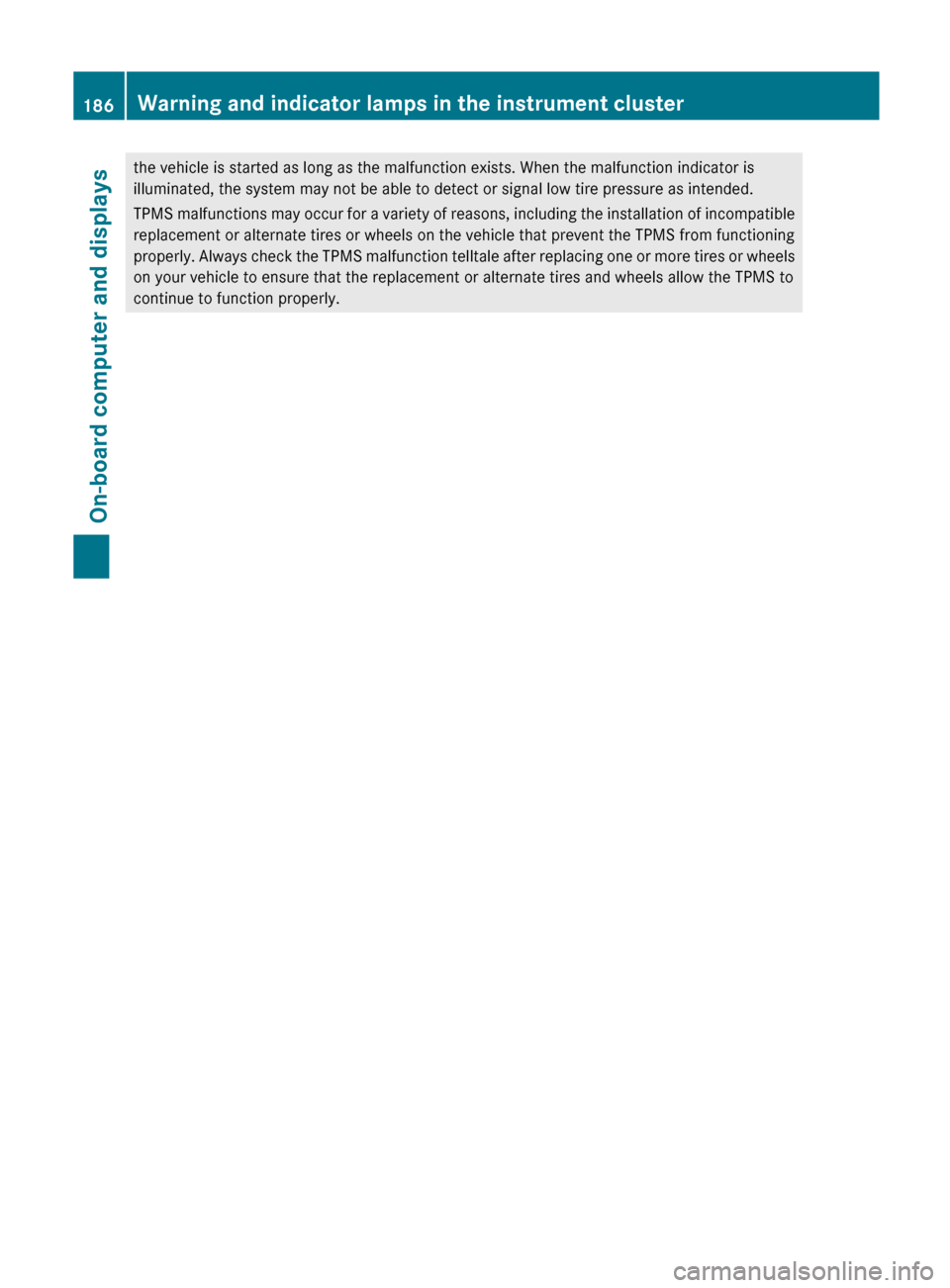
the vehicle is started as long as the malfunction exists. When the malfunction indicator is
illuminated, the system may not be able to detect or signal low tire pressure as intended.
TPMS
malfunctions
may occur for a variety of reasons, including the installation of incompatible
replacement or alternate tires or wheels on the vehicle that prevent the TPMS from functioning
properly. Always check the TPMS malfunction telltale after replacing one or more tires or wheels
on your vehicle to ensure that the replacement or alternate tires and wheels allow the TPMS to
continue to function properly. 186
Warning and indicator lamps in the instrument cluster
On-board computer and displays
Page 189 of 284
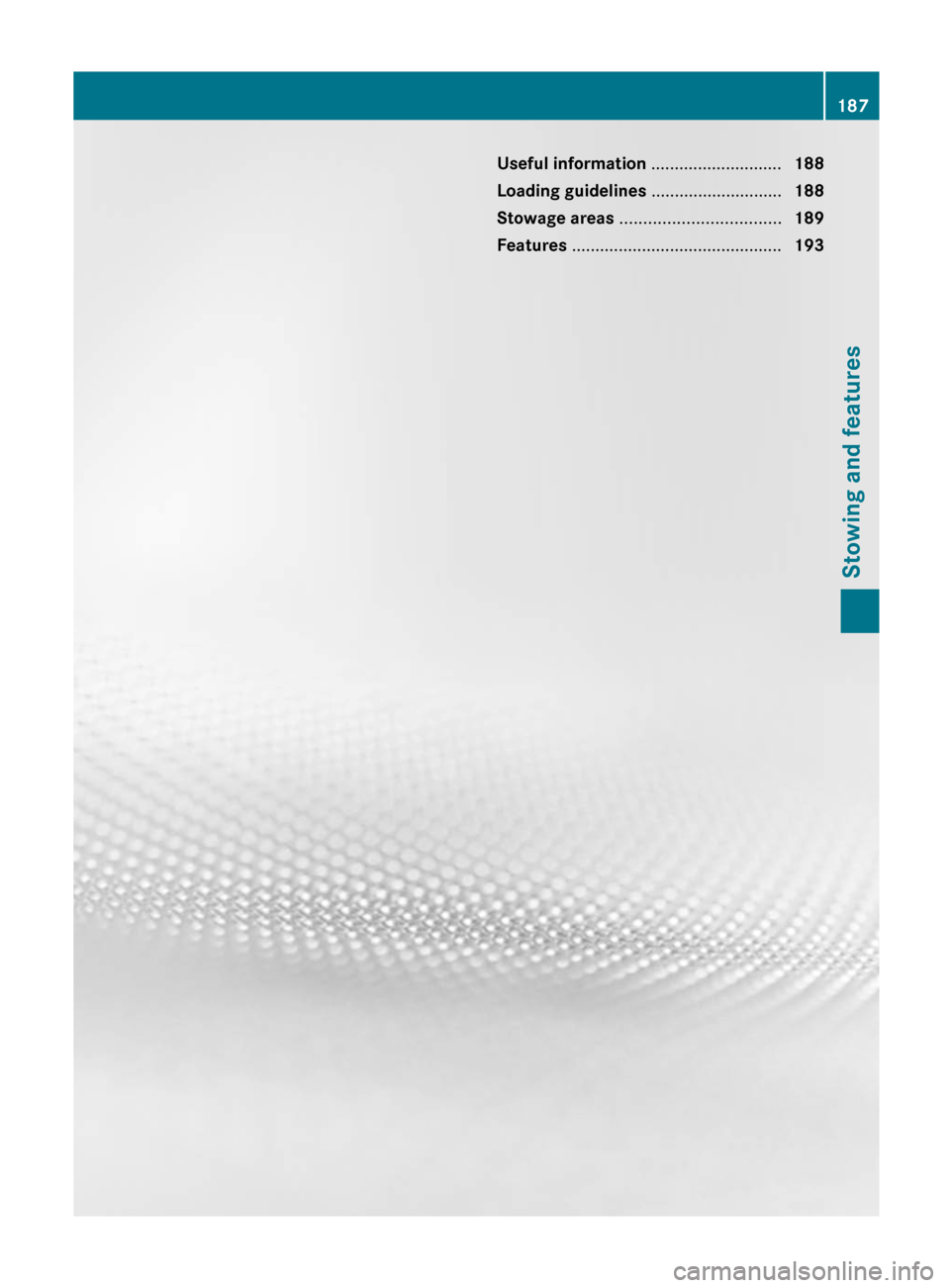
Useful information ............................
188
Loading guidelines ............................188
Stowage areas .................................. 189
Features ............................................. 193 187Stowing and features
Page 190 of 284
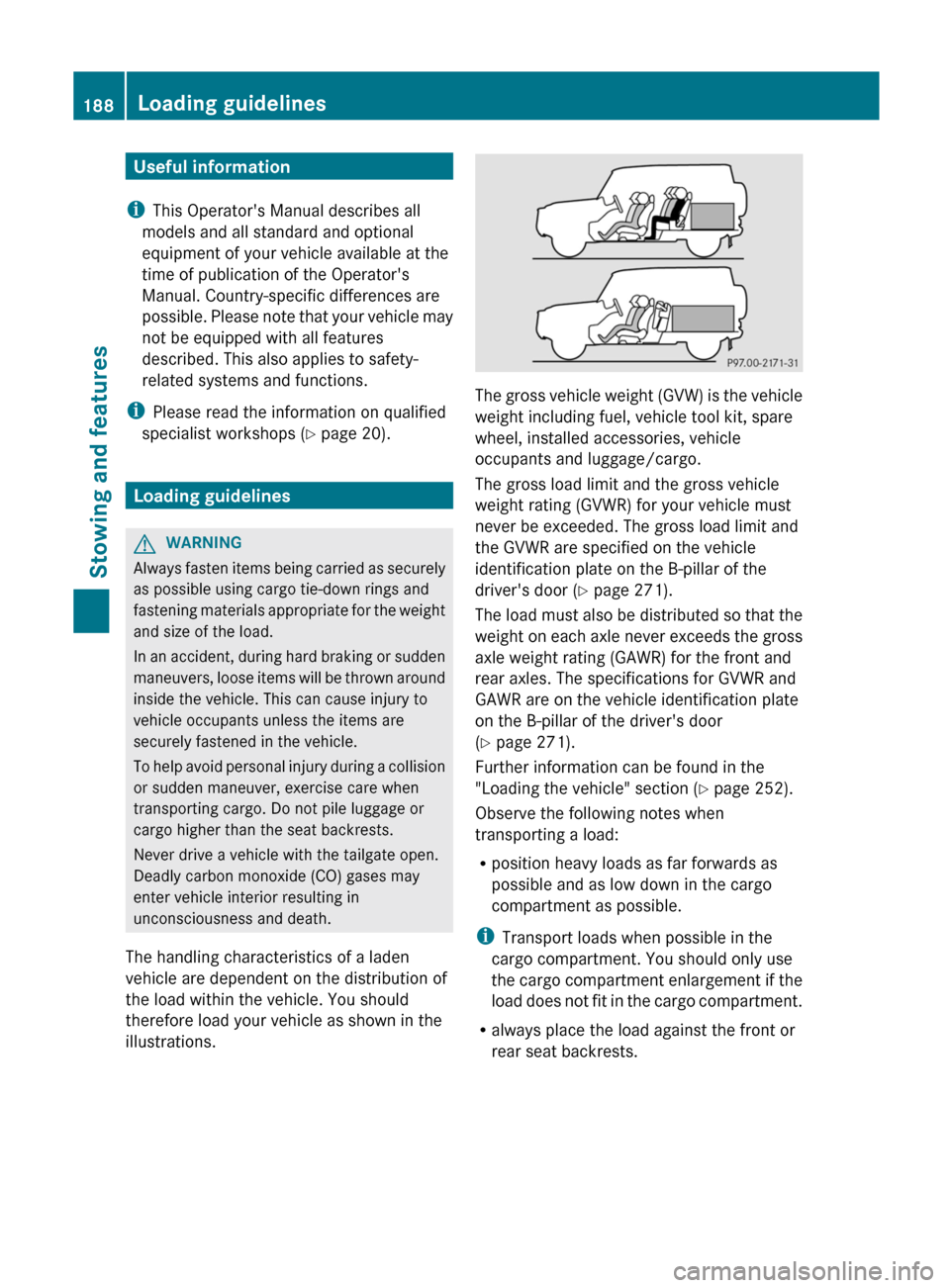
Useful information
i This Operator's Manual describes all
models and all standard and optional
equipment of your vehicle available at the
time of publication of the Operator's
Manual. Country-specific differences are
possible. Please
note that your vehicle may
not be equipped with all features
described. This also applies to safety-
related systems and functions.
i Please read the information on qualified
specialist workshops (Y page 20). Loading guidelines
G
WARNING
Always
fasten items being carried as securely
as possible using cargo tie-down rings and
fastening materials
appropriate for the weight
and size of the load.
In an accident, during hard braking or sudden
maneuvers, loose items will be thrown around
inside the vehicle. This can cause injury to
vehicle occupants unless the items are
securely fastened in the vehicle.
To help avoid personal injury during a collision
or sudden maneuver, exercise care when
transporting cargo. Do not pile luggage or
cargo higher than the seat backrests.
Never drive a vehicle with the tailgate open.
Deadly carbon monoxide (CO) gases may
enter vehicle interior resulting in
unconsciousness and death.
The handling characteristics of a laden
vehicle are dependent on the distribution of
the load within the vehicle. You should
therefore load your vehicle as shown in the
illustrations. The
gross vehicle weight (GVW) is the vehicle
weight including fuel, vehicle tool kit, spare
wheel, installed accessories, vehicle
occupants and luggage/cargo.
The gross load limit and the gross vehicle
weight rating (GVWR) for your vehicle must
never be exceeded. The gross load limit and
the GVWR are specified on the vehicle
identification plate on the B-pillar of the
driver's door ( Y page 271).
The load
must also be distributed so that the
weight on each axle never exceeds the gross
axle weight rating (GAWR) for the front and
rear axles. The specifications for GVWR and
GAWR are on the vehicle identification plate
on the B-pillar of the driver's door
(Y page 271).
Further information can be found in the
"Loading the vehicle" section ( Y page 252).
Observe the following notes when
transporting a load:
R position heavy loads as far forwards as
possible and as low down in the cargo
compartment as possible.
i Transport loads when possible in the
cargo compartment. You should only use
the cargo compartment enlargement if the
load does not fit in the cargo compartment.
R always place the load against the front or
rear seat backrests.188
Loading guidelines
Stowing and features